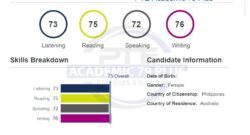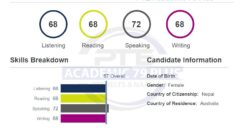Author: pte-aca
PTE Listening Tips
Focus on the task: It is essential to focus on the task at hand, listen attentively to the audio, and read the instructions carefully before attempting to answer the questions. Anticipate the context: Try to anticipate the context of the audio by looking at the title, subtitle, and visual cues if available. This will help you better understand the audio and answer the questions. Practice active listening: Active listening involves being fully present and engaged in the audio. It involves listening for main ideas, details, and inferences. Try to practice active listening in your daily life by listening to podcasts or audio recordings and summarizing what you heard. Note-taking: Taking notes is an essential part of the listening process, especially in the PTE listening section. Write down key points, such as names, numbers, dates, and unfamiliar vocabulary, which can help you answer the questions accurately. Manage your time: The PTE listening section is timed, so it is essential to manage your time effectively. Try to answer the easier questions first and then move on to the more challenging ones. Make sure you allocate sufficient time to review your answers. Use the right format: Ensure that you answer the questions in the correct format. Practice regularly: Practice makes perfect, so try to practice the PTE listening section regularly to become familiar with the test format and develop your listening skills. You can use practice materials and mock tests available online to simulate the actual test environment. (Practice with our 10 full scored Mock Tests portal) 79+ PTE Practice Platform and Mock Tests(Computer Version)
10 tips to get higher score in PTE
Understand the test format: Make sure you are familiar with the format of the PTE test, including the types of questions and the time limits for each section. Improve your English language skills: This is the most important factor in achieving a high score. Practice speaking, writing, reading, and listening to English as much as possible. Practice mock tests: Taking practice tests can help you get used to the format of the test and identify your weaknesses. (Practice with our 10 full scored Mock Tests portal) Manage your time: During the test, be sure to manage your time effectively so you have enough time to answer all the questions. Read the instructions carefully: Make sure you read and understand the instructions for each section of the test. Speak clearly: In the speaking section, make sure you speak clearly and at an appropriate pace. Use correct grammar and vocabulary: Pay attention to your grammar and vocabulary usage in the writing and speaking sections. Listen carefully: In the listening section, make sure you listen carefully to the recordings and answer the questions accordingly. Stay focused: During the test, stay focused and avoid distractions. Relax and be confident: Finally, try to stay calm and confident during the test. Remember that you have prepared well and you are capable of achieving a high score. 79+ PTE Practice Platform and Mock Tests(Computer Version)
PTE Describe Image Template
Introduction: Start by introducing the image and giving some background information about it. Mention the type of image (e.g. graph, chart, diagram, map) and briefly describe the topic it covers. Body: Begin by describing the main features of the image, starting from the most general to the most specific. Mention any trends, patterns, or significant changes that are visible in the image. Use appropriate language to describe the data or information in the image, such as percentages, figures, or units of measurement. Provide examples or additional details to support your analysis of the image. Use linking words and phrases to connect your ideas and create a coherent narrative. Conclusion: Summarize the main points of your analysis and draw a conclusion based on the information presented in the image. Provide your overall interpretation of the image and suggest any possible implications or recommendations. Use concluding language to wrap up your response, such as “In conclusion,” “To sum up,” or “Overall.” Here’s an example of how you could use this template to describe a graph: Introduction: The image shows a line graph that displays the number of visitors to a theme park in a year. Body: The graph illustrates the number of visitors to a theme park over the course of a year, from January to December. Overall, there was an upward trend in the number of visitors, with the highest number of visitors recorded in August. The number of visitors in January was around 10,000, and it increased gradually to around 30,000 in August. After August, there was a gradual decline in the number of visitors until December, when it dropped to around 5,000. The pattern of the graph suggests that the theme park is most popular during the summer months and least popular during the winter months. Conclusion: In conclusion, the line graph shows a clear trend of increasing visitor numbers at the theme park during the summer months, peaking in August, followed by a gradual decline towards the end of the year. This suggests that the theme park may want to focus its marketing efforts on the summer months to attract more visitors. Practice Describing image with our Portal by clicking here 79+ PTE Practice Platform and Mock Tests(Computer Version)
PTE Read Aloud Tips and Tricks
PTE Read Aloud is a challenging task that requires a combination of good pronunciation, fluent delivery, and good comprehension skills. Here are some tips and tricks that can help you improve your performance in PTE Read Aloud: Practice your pronunciation: PTE Read Aloud requires you to pronounce words and phrases accurately. So, practice your pronunciation regularly by reading aloud and recording yourself. Listen to the recordings to identify areas where you need to improve. Improve your vocabulary: Building your vocabulary can help you understand the text better and pronounce words correctly. So, read books, newspapers, and other materials to increase your vocabulary. Read the text silently first: Before reading aloud, read the text silently to get an idea of what it is about. This will help you to read it more fluently and with a better understanding. Pay attention to intonation and stress: Use intonation and stress to convey the meaning of the text. Stress the important words and phrases to make them stand out and use rising and falling intonation to convey emotions. Use appropriate speed: Read at a moderate pace, not too fast or too slow. This will help you to maintain fluency and clarity in your delivery. Practice time management: You will have limited time to read the text aloud, so practice time management. Read the text within the given time, without rushing or pausing too long. Use appropriate volume: Speak at an appropriate volume, neither too loud nor too soft. This will ensure that the evaluator can hear you clearly. Practice with different types of texts: Practice reading aloud with different types of texts, such as news articles, academic texts, and general interest articles. This will help you to become familiar with different styles of writing. Record and listen to yourself: Record yourself while practicing and listen to the recording to identify areas where you need to improve. This will help you to identify mistakes and improve your delivery. Be confident: Finally, be confident when reading aloud. Believe in your abilities and do your best to deliver the text with clarity and fluency. By following these tips and practicing regularly, you can improve your performance in PTE Read Aloud and achieve your desired score. Practice read aloud with Scoring with 79+ AI Portal 79+ PTE Practice Platform and Mock Tests(Computer Version)




